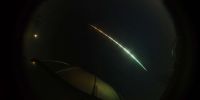| |

|
|
|
|
|
|
|
|
|
|
|
|
|
|
|
|
| 20 album su 2 pagina(e) |
1 |
|

| Immagini a caso - SOLAR SYSTEM |

007.jpgSpace Heat-Shields - The "Anomaly"181 visiteMa, dato che non c’è limite al peggio, questo secondo elemento che non quadra è avvalorato da un'ulteriore immagine 3D, sempre relativa alla stessa locazione. A distanza di pochi giorni (Sol 74) la “formazione” appare cresciuta in dimensioni e complessità, continuando però a non assomigliare neanche lontanamente al nostro "rottame spaziale" (cioè lo "Scudo Termico").
Da notare anche gli sferoidi chiari, sulla Dx dell’oggetto, che nella foto originale non potete vedere poichè coperti con lastre di pietra disegnate ad hoc (usando lo stesso procedimento impiegato per creare il finto "Heat-Shield").
La “crescita” dell’oggetto ci suggerisce una sua possibile origine organica in quanto esso, oltre a fuoriuscire dal terreno, si pare circondare di anelli particellari luminosi perpendicolari al suolo (con conseguente 'spazzolamento' discoidale a terra), forse causati da una sorta di fotosintesi eccitonica - o fenomeno analogo - apparentemente innescato dall'appendice tubolare anteriore semi-annegata nel terreno.
|
|

Tethys-PIA14581-PCF-LXTT-0.jpgTethys (False b/w - credits for the additional process.: Dr Paolo C. Fienga - Lunexit Team)194 visiteCaption NASA:"Saturn's moon Tethys shows off its tortured Surface in this Cassini Spacecraft image. On the top left of the image there is huge Odysseus Crater. On the bottom right, instead, there is Ithaca Chasma: a series of Scarps that run North-to-South across the moon for more than 620 miles (approx. 1000 Km). North on Tethys is up and rotated 25° to the right. This view looks toward the area between the Leading Hemisphere and Saturn-facing side of Tethys.
The image was taken in Visible Green Light with the Cassini Spacecraft narrow-angle camera on Sept. 14, 2011. The view was acquired at a distance of approximately 178.000 miles (approx. 287.000 Km) from Tethys and at a Sun-Tethys-Spacecraft, or Phase, Angle of 11°. Image scale is about 1 mile (1,6 Km) per pixel". MareKromium
|
|

Neq-Neptune-PIA00051.jpgNeptune in false colors53 visiteCaption NASA originale:"In this false color image of Neptune, objects that are deep in the atmosphere are blue, while those at higher altitudes are white. The image was taken by Voyager 2's wide-angle camera through an orange filter and two different methane filters. Light at methane wavelengths is mostly absorbed in the deeper atmosphere. The bright, white feature is a high altitude cloud just south of the Great Dark Spot. The hard, sharp inner boundary within the bright cloud is an artifact of computer processing on Earth. Other, smaller clouds associated with the Great Dark Spot are white or pink, and are also at high altitudes. Neptune's limb looks reddish because Voyager 2 is viewing it tangentially, and the sunlight is scattered back to space before it can be absorbed by the methane. A long, narrow band of high altitude clouds near the top of the image is located at 25° north latitude and faint hazes mark the equator and polar regions".
|
|

Jupiter_JUNO.gifUp, Down, like a Yo-Yo!90 visitenessun commentoMareKromium
|
|

Pan-PIA08230.jpgInside "Encke"...53 visiteCaption NASA originale:"Hiding within the Encke Gap is the small moon Pan, partly in shadow and party cut off by the outer A-Ring in this view. Similar to Atlas, Pan appears to have a slight ridge around its middle; and like Atlas, Pan's orbit also coincides with a faint ringlet. Pan is 26 Km(about 16 miles) across.
The image was taken in visible light with the Cassini spacecraft narrow-angle camera on June 30, 2006 at a distance of approximately 269.000 Km (such as about 167.000 miles) from Pan. Image scale is roughly 2 Km(approx. 5.259 feet) per pixel".
|
|
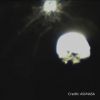
Dart-3.jpgGreat Balls of Fire! - 367 visitenessun commentoMareKromium
|
|

Titan-EB.jpgCrescent Titan: IR View, from N00152286 (Natural Colors; Special Processing by Elisabetta Bonora - Lunexit Team)54 visitenessun commentoMareKromium
|
|
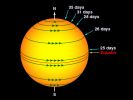
Solar_rotation.jpgThe "uneven" Solar Rotation130 visitenessun commentoMareKromium
|
|

| Ultimi arrivi - SOLAR SYSTEM |
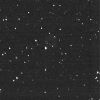
Voyagers-InterstellarSpace9-jpg.jpgVoyager 1 is still alive!110 visitenessun commentoMareKromiumFeb 04, 2024
|
|

Voyagers-InterstellarSpace8d.jpgThe Infinite and Beyond127 visitenessun commentoMareKromiumFeb 04, 2024
|
|

Enceladus-PIA20522enceladusC.jpgCrescent Enceladus (Credits: NASA/JPL/Cassini Imaging Team)114 visitePeering from the shadows, the Saturn-facing hemisphere of tantalizing inner moon Enceladus poses in this Cassini spacecraft image. North is up in the dramatic scene captured during November 2016 as Cassini's camera was pointed in a nearly sunward direction about 130,000 kilometers from the moon's bright crescent. In fact, the distant world reflects over 90 percent of the sunlight it receives, giving its surface about the same reflectivity as fresh snow. A mere 500 kilometers in diameter, Enceladus is a surprisingly active moon. Data and images collected during Cassini's flybys have revealed water vapor and ice grains spewing from south polar geysers and evidence of an ocean of liquid water hidden beneath the moon's icy crust.MareKromiumDic 31, 2023
|
|

Raffinerie.jpgI Love this!!!383 visiteI am sick and tired of the "Green B.S.". Our planet is sick, ok.
But "our" contributions to this situation are minimal. "Green" is just a color that now has become a great business and, at the same time, simple baby food for highly suggestible people.
Wake Up! And if you do not agree with me, it is your problem.
Basta con le cazzate eco-green: ci credono solo i fessi e gli incompetenti (ossia il 99% della popolazione mondiale). E comunque, anche se fossero vere tutte le balle che ci raccontano, ogni misura che ponessimo in essere ora sarebbe comunque futile e tardiva.
Pensateci su...MareKromiumNov 07, 2023
|
|

ZZ-Falling_on_Saturn.jpgEnd of Mission (Artistic View)272 visitenessun commentoMareKromiumOtt 15, 2023
|
|

Bardarbunga.jpgBardarbunga246 visiteMother Earth when is pissed...
And, please, do not confuse this funny-named Icelandic Volcano with the Italian "Bunga-Bunga" dance (or party)...MareKromiumAgo 15, 2023
|
|
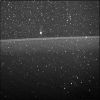
Jupiter-Juno-Rings.jpgFrom inside the Rings95 visitenessun commentoMareKromiumAgo 15, 2023
|
|

Ganymede_-_Juno.jpgGanymede from Juno99 visitenessun commentoMareKromiumAgo 15, 2023
|
|

|
|











